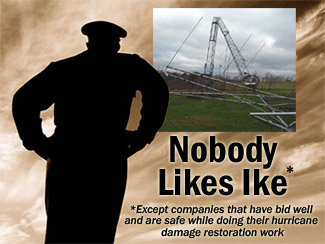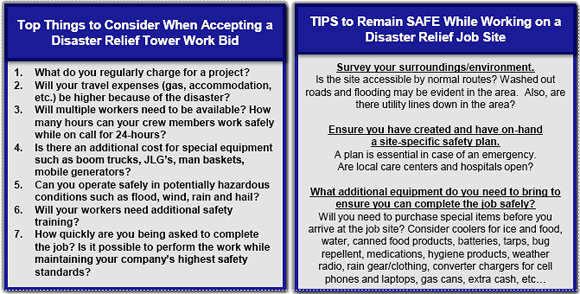|
Working safely should impact cost of tower contractors' storm restoration project bidding
September 11, 2008 - When Hurricane Andrew hit South Florida in 1992 it was recorded as the second most powerful, and last of three Category 5 hurricanes that made U.S. landfall during the 20th century.
It also created a license to print money for most Florida tower erection companies that took advantage of the communications catastrophe as government and the private sector had to rely upon a small labor force already capitalizing upon the burgeoning cellular build-out.
Following the disaster, the state's largest utility, Florida Power & Light Company, put in place a detailed plan from their lessons learned and were better equipped to weather and service their communications towers when Hurricane Charley decimated southwest Florida in 2004.
State police and other government agencies also organized response teams and realistic time and material contracts for future disasters, but interest outside of the state waned until Hurricane Katrina decimated the Gulf Coast.
Sharp spike in tower service requests
Tower contractor crews were again in high demand and were able to equitably charge for their specialized services to help restore the nation's largest ever communications infrastructure failure.
Carriers, broadcasters and government providers exhausted their preferred contractors, some of them with their facilities destroyed or under water, and were forced to reach out to any company that said that it could provide services.
Since Katrina, carriers and other companies reliant upon communications towers have taken broad steps to strengthen their emergency preparedness programs and it seems to have worked based upon post Hurricane Gustav assessments.
Carriers said that power supply was no longer a leading issue since most sites have been hardened with backup systems since Katrina.
Recalling the confusion and lack of coordination during Katrina, Bruce Holsted, an Arkansas contractor, who was doing service work for Entergy following Gustav's wake in Baton Rouge, was quick to notice the difference, especially in the government sector.
"The state and local governments were way ahead of the curve here. They were on point with generators, food and fuel at the right locations. I was completely amazed at how efficient government was in this setting," he said
The greater the storm, the bigger the payday
However, Hurricane Ike's impact might be more destructive as it surges towards its projected Saturday morning field goal posts of Galveston and Corpus Christi with possibly Category 3 or 4 winds.
Carriers have used different payment models during past storms, some paying contractors 50-to-75% of their full rate for remaining on standby and between $115 to $135 per man-hour plus materials for hours worked.
A number of contractors said that Gustav's emergency project pricing wasn't as high through negotiated contracts with the carriers and the work quickly turned to low bid awards to complete important, but non-critical network maintenance projects.
"As they've done for the past number of years, they've tried to squeeze the contractors to trim their budgets. Emergency work is no different," said a long-established Gulf States contractor, who noted that safety sometimes takes a back seat when only low bids are accepted to meet ambitious project deadlines.
"If the storm is severe and takes down their network, then you're going to see prices elevate to where they should be. They will have no choice due to the limited number of contractors available that can immediately serve them," he said.
"Nobody wants to see a catastrophe that would extend the weeks of work because that means your home and business were effected. But you would be a fool not to get the most you can for your hard work. Relationships that we could always count upon no longer exist in this business," said a Texas contractor who is currently readying three crews for emergency restoration.
NATE champions contractor safety
With Ike barreling towards the coastline, The National Association of Tower Erectors urged contractors this week to consider several things before inking a disaster relief contract.
The association says that it believes that safety must always remain top of mind and proper safety procedures need to be taken into account when calculating the risks and financial rewards of disaster relief jobs.
The organization of tower erection and maintenance contractors has provided a number of tips to ensure safety while working on an emergency project. It also provided a number of suggestions for items that should be reviewed for inclusion in a bid package.
Their safety bulletin said, "Do not be pushed to complete tasks faster than you can safely. Safety needs to remain the number one priority on all job sites, even more so regarding disaster relief work."
It also emphasized that pricing should include the following considerations:

Carriers are using their Gustav handbooks
Wireless and wireline carriers were looking to their Gustav handbooks to prepare for Hurricane Ike. AT&T said it was taking such steps as boosting its wireless network capacity, ensuring backup batteries were working at cell sites and protecting against flooding. In the wake of Hurricane Katrina, many carriers invested millions in equipment and system upgrades in the Gulf Coast, including Cellular South, which has pumped $15 million in equipment and upgrades since then.
AT&T spokesman Dan Feldstein said the company has people across Texas on standby, both on the landline and wireless sides of its business. Technicians in areas where the storm does not hit can move to areas that are damaged.
"Unfortunately, there has been a lot of practice this year and it has gone extremely well," he said.
|